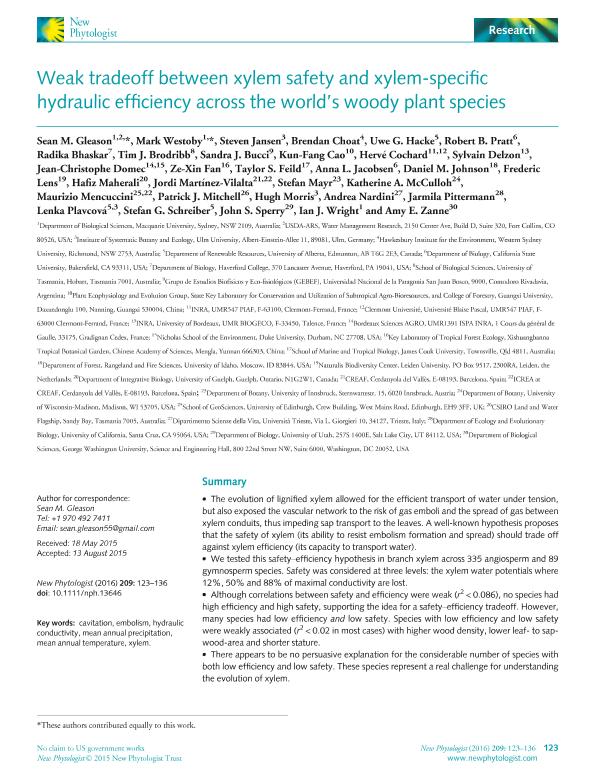Artículo
Weak tradeoff between xylem safety and xylem-specific hydraulic efficiency across the world's woody plant species
Gleason, Sean M.; Westoby, Mark; Jansen, Steven; Choat, Brendan; Hacke, Uwe G.; Pratt, Robert B.; Bhaskar, Radika; Brodibb, Tim J.; Bucci, Sandra Janet ; Cao, Kun-Fang; Cochard, Hervé; Delzon, Sylvain; Domec, Jean-Christophe; Fan, Ze-Xin; Feild, Taylor S.; Jacobsen, Anna L.; Johnson, Daniel M.; Lens, Frederic; Maherali, Hafiz; Martínez-Viralta, Jordi; Mayr, Stefan; McCulloh, Katherine A.; Mencuccini, Maurizio; Mitchell, Patrick J.; Morris, Hugh; Nardini, Andrea; Pittermann, Jarmila; Plavcová, Lenka; Schreiber, Stefan G.; Sperry, John S.; Wright, Ian J.; Zanne, Ami E.
; Cao, Kun-Fang; Cochard, Hervé; Delzon, Sylvain; Domec, Jean-Christophe; Fan, Ze-Xin; Feild, Taylor S.; Jacobsen, Anna L.; Johnson, Daniel M.; Lens, Frederic; Maherali, Hafiz; Martínez-Viralta, Jordi; Mayr, Stefan; McCulloh, Katherine A.; Mencuccini, Maurizio; Mitchell, Patrick J.; Morris, Hugh; Nardini, Andrea; Pittermann, Jarmila; Plavcová, Lenka; Schreiber, Stefan G.; Sperry, John S.; Wright, Ian J.; Zanne, Ami E.
 ; Cao, Kun-Fang; Cochard, Hervé; Delzon, Sylvain; Domec, Jean-Christophe; Fan, Ze-Xin; Feild, Taylor S.; Jacobsen, Anna L.; Johnson, Daniel M.; Lens, Frederic; Maherali, Hafiz; Martínez-Viralta, Jordi; Mayr, Stefan; McCulloh, Katherine A.; Mencuccini, Maurizio; Mitchell, Patrick J.; Morris, Hugh; Nardini, Andrea; Pittermann, Jarmila; Plavcová, Lenka; Schreiber, Stefan G.; Sperry, John S.; Wright, Ian J.; Zanne, Ami E.
; Cao, Kun-Fang; Cochard, Hervé; Delzon, Sylvain; Domec, Jean-Christophe; Fan, Ze-Xin; Feild, Taylor S.; Jacobsen, Anna L.; Johnson, Daniel M.; Lens, Frederic; Maherali, Hafiz; Martínez-Viralta, Jordi; Mayr, Stefan; McCulloh, Katherine A.; Mencuccini, Maurizio; Mitchell, Patrick J.; Morris, Hugh; Nardini, Andrea; Pittermann, Jarmila; Plavcová, Lenka; Schreiber, Stefan G.; Sperry, John S.; Wright, Ian J.; Zanne, Ami E.
Fecha de publicación:
17/09/2015
Editorial:
Wiley Blackwell Publishing, Inc
Revista:
New Phytologist
ISSN:
0028-646X
Idioma:
Inglés
Tipo de recurso:
Artículo publicado
Clasificación temática:
Resumen
* The evolution of lignified xylem allowed for the efficient transport of water under tension, but also exposed the vascular network to the risk of gas emboli and the spread of gas between xylem conduits, thus impeding sap transport to the leaves. A well-known hypothesis proposes that the safety of xylem (its ability to resist embolism formation and spread) should trade off against xylem efficiency (its capacity to transport water).
* We tested this safety–efficiency hypothesis in branch xylem across 335 angiosperm and 89 gymnosperm species. Safety was considered at three levels: the xylem water potentials where 12%, 50% and 88% of maximal conductivity are lost.
* Although correlations between safety and efficiency were weak (r2 < 0.086), no species had high efficiency and high safety, supporting the idea for a safety–efficiency tradeoff. However, many species had low efficiency and low safety. Species with low efficiency and low safety were weakly associated (r2 < 0.02 in most cases) with higher wood density, lower leaf- to sapwood-area and shorter stature.
* There appears to be no persuasive explanation for the considerable number of species with both low efficiency and low safety. These species represent a real challenge for understanding the evolution of xylem.
Palabras clave:
Cavitation
,
Embolism
,
Hydraulic Conductivity
,
Xylem
Archivos asociados
Licencia
Identificadores
Colecciones
Articulos(CCT-CENPAT)
Articulos de CTRO.CIENTIFICO TECNOL.CONICET - CENPAT
Articulos de CTRO.CIENTIFICO TECNOL.CONICET - CENPAT
Citación
Gleason, Sean M.; Westoby, Mark; Jansen, Steven; Choat, Brendan; Hacke, Uwe G.; et al.; Weak tradeoff between xylem safety and xylem-specific hydraulic efficiency across the world's woody plant species; Wiley Blackwell Publishing, Inc; New Phytologist; 209; 1; 17-9-2015; 123–136
Compartir
Altmétricas



